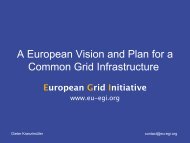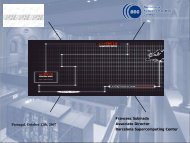e-Infrastructures Roadmap - Internet Society Nederland
e-Infrastructures Roadmap - Internet Society Nederland
e-Infrastructures Roadmap - Internet Society Nederland
- No tags were found...
Create successful ePaper yourself
Turn your PDF publications into a flip-book with our unique Google optimized e-Paper software.
e-<strong>Infrastructures</strong> <strong>Roadmap</strong>Lowering time-to-science and just-in-time acquisitionWith investments in ICT timing is a key issue: it is clearly often disadvantageous to be too early asinvestments in ICT hardware have to be written off very fast. Let’s take the example of supercomputers:during the last twenty years it took about seven years for the fastest computer in the world at a certainpoint in time to disappear from the top 500 of available systems – in fact being surpassed by cheapnew systems that cost less than 1% of the original price. Every month that such a system is not fullyutilised during its first years of deployment is extremely costly indeed – with a price tag in the orderof magnitude of one to five million Euro per month. 12 Any technological glitches are often the riskof the buyer. Deployment of immature technology is not only very costly in this respect, but can bevery time-consuming for the scientists involved – with a slowdown of development and decreasedenthusiasm and support from the scientific community as a result.However, it is equally dangerous and demotivating to be too late: if scientists from inside the EU havea structural competitive disadvantage through lack of appropriate resources. Their research will sufferand they will probably miss out on the commercial spin-off entirely. Global R&D expenditure on acomputationally intensive research area as pharmaceutics alone is estimated to be over 40 billion Europer year, with an average increase of 5.4%. The development of new medicines takes an average of12 years. 13 A medicine can only be patented once, so the stakes are high in the race to be the firstone to apply for the patent – the outcome of which will make the difference between a huge profitor a huge loss.Time-to-science (from proposal to deployment) for a very large resource takes at least half a year –and often much longer. So waiting until the science is ready would in any case waste valuable manyears. Making sure the needs of the researchers and the timing of investments are optimally alignedis a strategic activity with significant risks of ending up with very expensive capacity too early whilelacking vital capacity later on. The risk to be just in time to invest in exactly the right technologycan easily be reduced once an e-Infrastructure is in place. 13 If there is a pool of resources that is sharedat a European level, allocation of resources can take place much faster – significantly loweringtime-to-science. 15 If there is a need for more resources than what is available, these can be constructedjust in time. Because of the larger overall volume of facilities individual projects with urgentrequirements can be facilitated faster.Enabling a European Science GridIn this <strong>Roadmap</strong> we use the term European Science Grid (in singular, even though it would arguablybe more accurate to use the plural) in order to describe the pool of resources that are somehowavailable through any of the grid environments running at a given moment in time and that arepredominantly driven by European incentive – along with the technological and organisationalefforts that are in place to bring them together. The vision of a single monolithic integrated Euro-pean grid environment is probably no more desirable than a similar monolithic integrated global gridenvironment, as it will lead to a bloated and hardly usable facility. We can imagine the outlines ofsuch a concept if we think of what enormous opportunities would arise if we could create a grid ofgrids, or a virtual meta-grid able to interconnect all the grids in Europe (and ultimately in the world)together without actual low-level integration.Why choose the boundaries of Europe as the appropriate level to optimize? There are of course othercriteria one can sensibly use to single out a group of grids, such as disciplinary boundaries or nationalor smaller regional boundaries at which major funding is shared. Such boundaries are meaningful andhave their own economic reward in increased effectiveness – and in the case of national grids increasedcompetitiveness among the member states. As such they won’t need support from a Europeanperspective to be sustainable – except perhaps in cases where help is required to help grid nascentcountries participate in pan-European initiatives. The European level is however in most cases morerelevant since one needs critical mass and a strong mutual commitment. The European Union is alogical choice as it interconnects heavily on an economic level and has increasingly shared funding.Grid technology is a major enabler for world-wide partnership and teamwork, catalysing interactionbetween major and minor players in the e-Science field and beyond, while providing new ideas andpossibilities to apply best practices learned from others to develop services in each research centre.The European e-Infrastructure will – through the European Science Grid and other tools provides– support more intense collaboration between various research centres and their researchers than everbefore. The European Science Grid will embed the concept of Europe strongly within its infrastructureas it will quite naturally strive towards mutual interdependency by promoting an architecture thatoptimises availability and cost efficiency of scientific facilities not on a national level but within theEuropean borders.12 Estimate: Netherlands National Computing facilities foundation, 2005.13 Source: Centre for Medicines Research International, www.cmr.com.14 With new technologies such as hybrid networking Europe is indeed leading the world, which makes Europe moreattractive to invest in. An additional advantage of getting in at the right time is that one can profi t from the partnershipwith industry that is always keen to prove their technology is ready for large scale deployment. The only way to do thisin a sensible way is on a European scale.15 One such collaboration that pools resources is DEISA (Distributed European Infrastructure for Supercomputing14 Applications), which interconnects the individual systems from a number of supercomputing centers to form a distributedterascale supercomputing facility by using grid technologies.15







